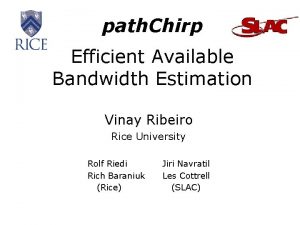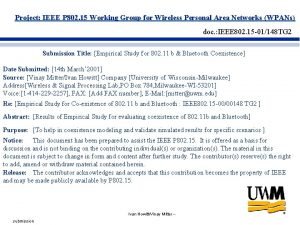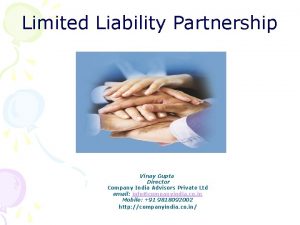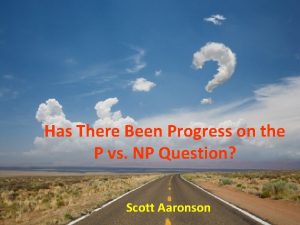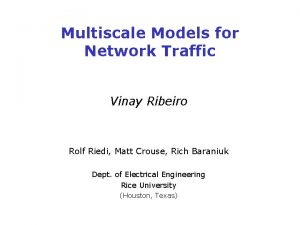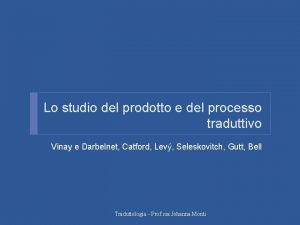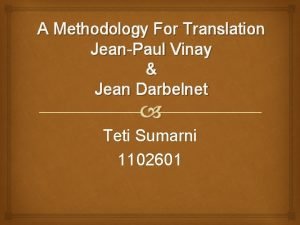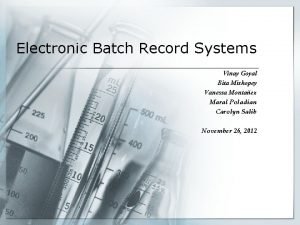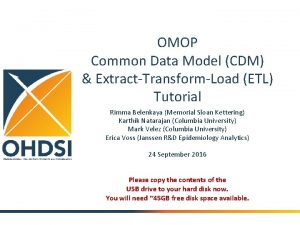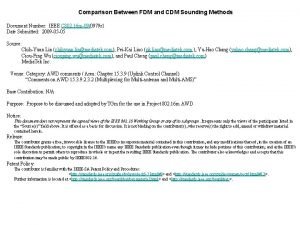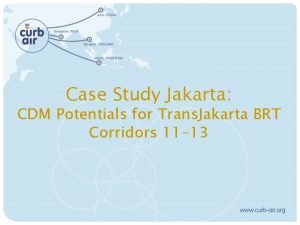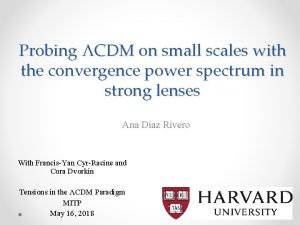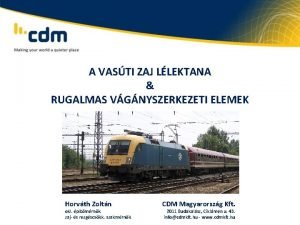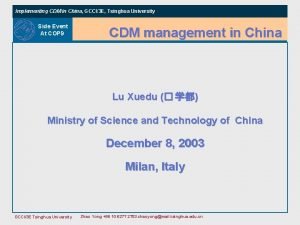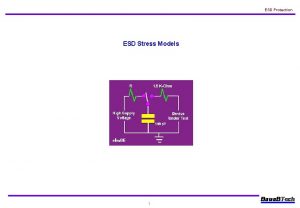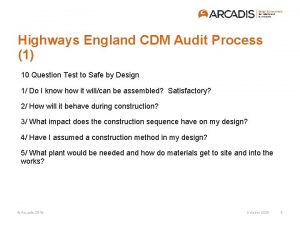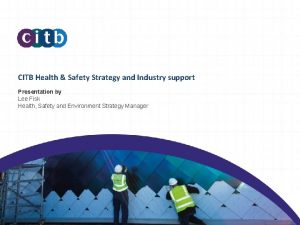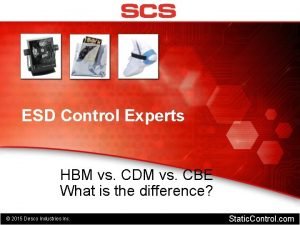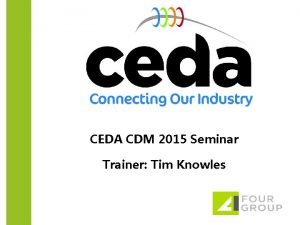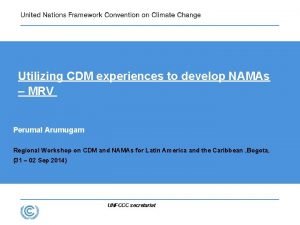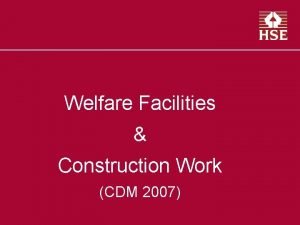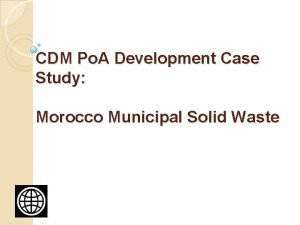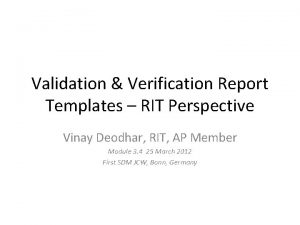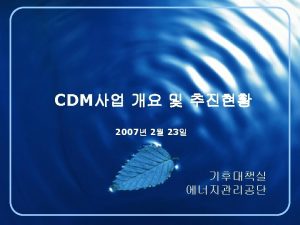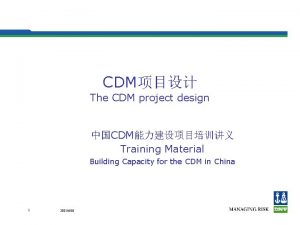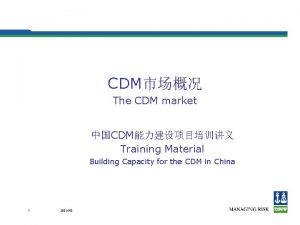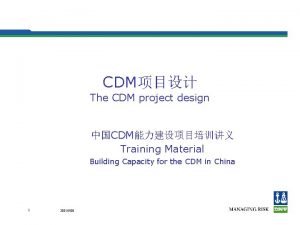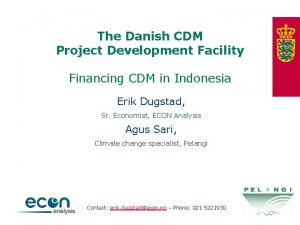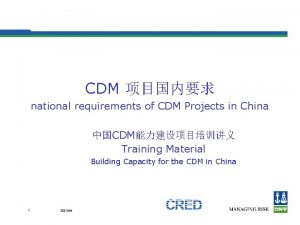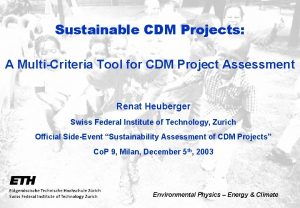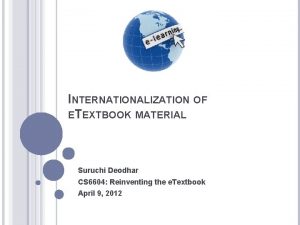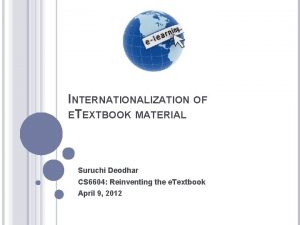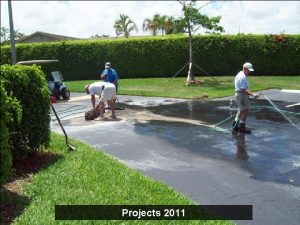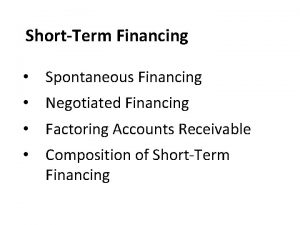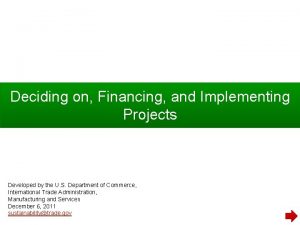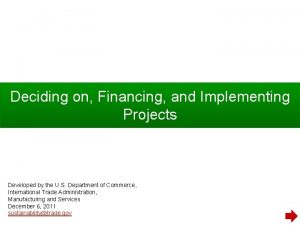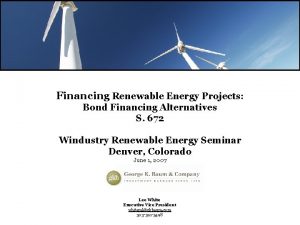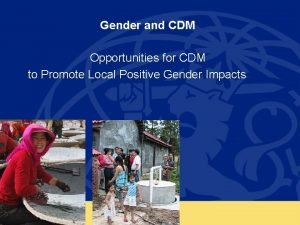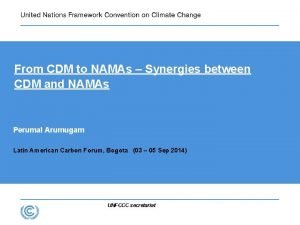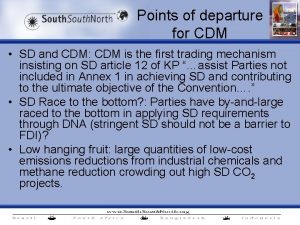Financing CDM Projects Vinay Deodhar Workshop on CDM






![India’s GHG Inventory GHG emissions from key sectors* • [with 5% or more contribution] India’s GHG Inventory GHG emissions from key sectors* • [with 5% or more contribution]](https://slidetodoc.com/presentation_image/d8676b371288d3c487e869938fb44cc3/image-7.jpg)























- Slides: 30

Financing CDM Projects Vinay Deodhar Workshop on CDM Opportunities in Rajasthan January 28 – 29, 2005 Jaipur

Outline • • • Introduction Potential sectors for CDM projects Clean Energy Project Development Normal Due diligence Carbon Finance Supplement 2

Introduction • Vinay Deodhar, Energy & Environmental Consultant-Adviser to CRISIL Infrastructure Advisory • CRISIL – A Credible independent organization providing Ratings, financial news, risk analysis, economic research, industry/company research and fund services • CRISIL Infrastructure Advisory Services provides policy/managerial advice to Government, Corporate sector and regulators • Specializes in power, urban infrastructure, industry, transportation infrastructure 3

CDM Centre of Excellence • CRISIL Infrastructure Advisory has been selected as a local partner for establishment of Co. E by Ecofys • Centre supported by British Commonwealth Office in its first year • Co. E to provide Technical Assistance to Project developers, SMEs and capacity building of key stakeholders like government ministries, SEBs, SERCs and FIs 4

The Project Finance Cake CDM Underlying Project Carbon Finance Analysis Conventional Due Diligence Additionality Baseline HC Approval Risk analysis Promoter Sector analysis Profitability Risk analysis CDM offers only the Icing on the Cake! 5

Potential Sectors for CDM projects in India
![Indias GHG Inventory GHG emissions from key sectors with 5 or more contribution India’s GHG Inventory GHG emissions from key sectors* • [with 5% or more contribution]](https://slidetodoc.com/presentation_image/d8676b371288d3c487e869938fb44cc3/image-7.jpg)
India’s GHG Inventory GHG emissions from key sectors* • [with 5% or more contribution] Fuel Combustion – – – Energy & Transformation Industries Industry Transport • Industrial Processes • Agriculture – – Enteric Fermentation Rice cultivation 28. 9% 12. 3% 6. 5% 8. 4% 15. 3% 7. 0% * Source: India’s initial National Communication – June 2004 7

Energy Sector Largest potential for projects for generating Emission Reductions – – – Coal – Clean coal technologies like IGCC, Super critical process, coal beneficiation Fuel switch – coal/diesel based plants to Natural Gas/other cleaner fuels Renewable Energy – India blessed with solar, wind, biomass Waste to energy – emerging area needing greater attention Repowering – renovation and modernization, demand side management Energy efficiency – end use energy efficiency, reduction in specific energy consumption in supply of services such as litre water delivered, lumens of light provided, TOR in HVAC systems 8

Industrial Energy Specific energy consumption improvement projects – – – Major contributors – steel, aluminium, pulp & paper, textiles, sugar, chemicals and fertilizers, bulk chemicals, cement, petrochemicals etc. Options – waste heat recovery, efficient cycles, new materials, efficient energy recovery/conversion equipment, process integration through heat exchanger networking Alternate fuels like biomass, wastes 9

Industrial Processes Specific to the industries – some examples – – – – Iron & Steel – alternate materials for reduction of metal, gas capture from furnaces, CO 2 recovery from BF, optimization of coal and graphite electrodes in electric arc furnace Distilleries – capture of CO 2 from fermentation process Lime – CO 2 capture from limestone kilns (in cement, construction, paper, sugar industries) Carbide – optimization coal used in reduction, and limestone used for producing Ca. O Aluminium – optimization of electrolysis to reduce emission of CO 2, use of alternate anode materials and processes to reduce anode effects that release per fluoro carbons Nitric Acid – capture of N 2 O by extended absorption, selective catalytic reduction Circuit Breakers – technologies to reduce emissions of SF 6 from sparking effects in power lines Dairy – Efficient manure management to reduce methane emission 10

Transport Sector • Switch over from road to rail for cargo transport • Promotion of waterways • Transport/traffic planning – staggered work timing, redistribution of work and domestic spaces, effective master planning • Alternate fuels like CNG, bio-diesel, blending agro based ethanol, battery operated vehicles 11

Urban Sector • • • Efficient water management to reduce wastage and pumping load Better street lighting with efficient lamps Building energy use efficiency improvement Plantation and afforestation wherever possible Proper MSW collection, transport, treatment and disposal Proper wastewater planning and management 12

Clean Energy Project Development

What is a Clean Energy Project? Any project that employs a “better than business as usual” technology that substantially reduces GHG emissions per unit of energy produced or consumed or per unit of product or service produced. 14

CDM Project Structure Financing Structures for CDM Projects in India and Capacity Building Options for EU-Indo Collaboration, Vinay Deodhar, Axel Michaelowa, Matthias Krey HWWA Discussion Paper 247, September 2003 15

Normal Due Diligence Needs Prior to GHG Analysis - Traditional Analysis – Promoters’ capabilities and credit worthiness and resources – Market analysis- Demand supply gaps, Sustainability of the project activity – Project Structure • With recourse to promoters books or • Without BOO, BOOT, BOOM – – Available revenue streams- sale of services generated Profitability indicators- IRR, DSCR, NPV Risk Analysis Underlying Contracts- terms and other elements 16 Remember GHG Analysis is closely linked to the conventional project analysis

Steps in Project Analysis 1. 2. Review if carbon finance is right for the project Review the project to ensure that: a) it can be realistically implemented, b) reduces GHG emissions, and c) can assist India in achieving sustainable development 3. Choose a business model: the traditional corporation vs. the special purpose vehicle 4. Estimate the project cost, profitability from projections 5. Complete a basic projected Income Statement for the project 6. Estimate the discount or hurdle rate 7. Calculate the Net Present Value 8. Calculate the Levelized Cost of the Project (optional) 9. Identify Project Risk Factors 10. Distinguish between qualitative and quantitative risk 11. Develop a Risk Matrix 12. Decide the appropriate level of Debt the project Contd…. 17

Steps in Project Analysis 13. 14. 15. 16. 17. 18. 19. 20. 21. Decide the company’s investment hurdle rate (or Cost of Capital) Recalculate the project’s net present value (NPV) Decide the best risk mitigation procedures for the project Put in place the appropriate contract (s) Decide what type of ‘back-up’ the project needs to cover nonproject based Risk (Risk Insurance, Guarantee, Leases, etc…) Calculate the Price per metric ton of emission reductions Calculate the total revenue from potential carbon sales Incorporate carbon revenues into the cash flow analysis Decide on the right model to sell the Reductions 18

Lender Requirements • Loan Application Review Process – – – Promoter Credentials Sector Analysis – Demand Supply gaps Project Feasibility studies Risk Analysis Due diligence process • • Technical Economic/financial Legal/contractual/ Political Environmental • Lender’s perspective – If risk is inappropriately allocated, credit enhancement from a creditworthy third party may be necessary to mitigate risk to lender 19

The Carbon Finance Supplement 20

GHG Mitigation Checklist • Does the Project result in real, quantifiable, measurable, GHG emission reduction? • Does it satisfy the host country sustainable development criteria? • Is it’s cost higher than the least cost option meeting all the legal requirements of India? • Does it satisfy the Additionality criteria? • Is it possible to develop a baseline methodology that is consistent with the Additionality criteria? 21

Establishing the Additionality Tool for the demonstration and assessment of additionality Step 0: Preliminary screening based on the starting date of the project activity PASS Step 1: Identification of alternatives to the project activity with current laws and regulations PASS Step 2: Investment Analysis Step 3: Barrier Analysis PASS Step 4: Common Practice PASS Step 5: Impact of CDM Registration PASS Project Activity is Additional Source: EB 16 Report Annex 1 22

Steps in Developing a CDM Project • In parallel with DPR, identify appropriate “baseline methodology” if existing. Else propose a new methodology • Baseline – A scenario with least cost that could have prevailed in the absence of the CDM project activity • Estimate the baseline and project GHG emissions and Evaluate the emission reductions • Prepare the project design document (PDD), justification of Additionality – environmental, technical, investment and sustainable development as per latest tools • Apply and obtain the host country approval from CDM NA at MOEF • Identify and engage a DOE for validation of the above • Prepare an Emission Reductions Purchase Agreement (ERPA) • Make necessary changes as suggested by EB methodology panel and register the project • Locate a buyer. Negotiate and enter into the ERPA 23

Regulatory Mechanism for CDM COP/MOP Under UNFCCC World DOE CDM Executive Board (EB) CDM Registry Methodologies Panel/Desk Reviewers Host Countries DNA Baseline and monitoring methodologies, PDD Project Promoter 24

Rules of the Game Project Approval • In Non Annex 1 nation (Host Country) – Project has to meet SD criteria – Stakeholders consultation – Should receive approval from the HC Designated Nodal Agency (DNA) • International Level – Project Design Document (PDD), Baseline and monitoring and verification methodologies have to be approved by CDM Executive Board – Validation of the above delegated to “Designated Operational Entity” (DOE) approved by EB – DOE will make the above documents on CDM website for comments by concerned parties and EB members within a specified time – Registration by CDM EB – Monitoring and Verification by DOE* at predefined periods – Sale the CERs to party with mitigation target through an Emission Reduction Purchase Agreement (ERPA) * Could be the same DOE for Small Scale CDM projects 25

Don’t Forget the Complexities! Source: CDM institutions and procedures; Dr. Axel Michaelowa http: //www. hwwa. de/Projects/Res_Programmes/RP/Klimapolitik/HWWA_3392_HWWA_3391_Hintergrund_Kyoto 3. htm 26

Transaction Costs – At Each Stage! • Preparation of project documents – baseline and M&V methodologies, PDD, Additionality etc. need consulting time!! • Host Country approvals • Hiring of DOE for validation • Developing the ERPA and negotiating it with buyers • CDM registration costs depending on CERs* and adaptation tax (2% CERs retained by EB) • Estimated figures $ 150, 000 to $ 250, 000 In addition there will be cost for yearly verification * Ranges from US $ 10, 000 – $30, 000 27

Advantage Small Scale! • To bring small size projects in CDM ambit simplified modalities and procedures have been developed for “Small Scale” CDM (SSc CDM) Projects – renewable energy project activities with a maximum output capacity equivalent to up to 15 megawatts – energy efficiency improvement project activities which reduce energy consumption, on the supply and/or demand side, by up to the equivalent of 15 gigawatt hours per year – project activities that both reduce anthropogenic emissions by sources and directly emit less than 15 kilo tonnes of carbon dioxide equivalent annually – Afforestation and reforestation projects that sequester not more than 8 kilo ton of carbon dioxide • SSc CDM projects can use the simplified baselines accepted by EB • Lower registration cost $ 5, 000 • Same DOE can validate and monitor the projects 28

Opportunities in Rajasthan • Rajasthan endowed with bountiful sunshine – could easily harness solar energy for useful purpose • Solar water heaters, dryers, PV system operated pumps etc. • Rajasthan has a huge tourist potential – Energy conservation and use of renewables in hotels and industry offers yet another area for CDM projects • Wind energy potential is also sizeable, especially desert regions • Growth in urban centres leads to increasing generation of solid waste and wastewater, which could be used for generating energy in the form of power or cooking gas to replace fossil fuels • Finally, Rajasthan is industrializing fast, efficient use of energy therefore offers yet another avenue for developing CDM projects 29

Thank You for Your Attention!
 Vinay tyagi
Vinay tyagi Vinay ribeiro
Vinay ribeiro Vinay mitter
Vinay mitter Dr vinay gupta
Dr vinay gupta Vinay shet
Vinay shet P vs np progress
P vs np progress Vinay ribeiro
Vinay ribeiro Vinay amdhare
Vinay amdhare Vinay deolalikar
Vinay deolalikar Vinay e darbelnet
Vinay e darbelnet Vinay darbelnet a methodology for translation
Vinay darbelnet a methodology for translation Vinay and darbelnet 1958
Vinay and darbelnet 1958 How to convert paper br to electronic batch record
How to convert paper br to electronic batch record Omop tutorial
Omop tutorial Difference between fdm and cdm
Difference between fdm and cdm Trans cdm
Trans cdm Common domain model
Common domain model Central eastern italy
Central eastern italy Cdm probe
Cdm probe Rugalmas
Rugalmas Cdm cers
Cdm cers Hbm cdm mm
Hbm cdm mm Cdm audit
Cdm audit Www.citb.co.uk/cpcs downloads
Www.citb.co.uk/cpcs downloads Hbm vs cdm
Hbm vs cdm Cdm trainers
Cdm trainers Parcours edf cdm 2018
Parcours edf cdm 2018 Cdm
Cdm Omop cdm
Omop cdm Cdm welfare facilities
Cdm welfare facilities Cdm.po
Cdm.po

